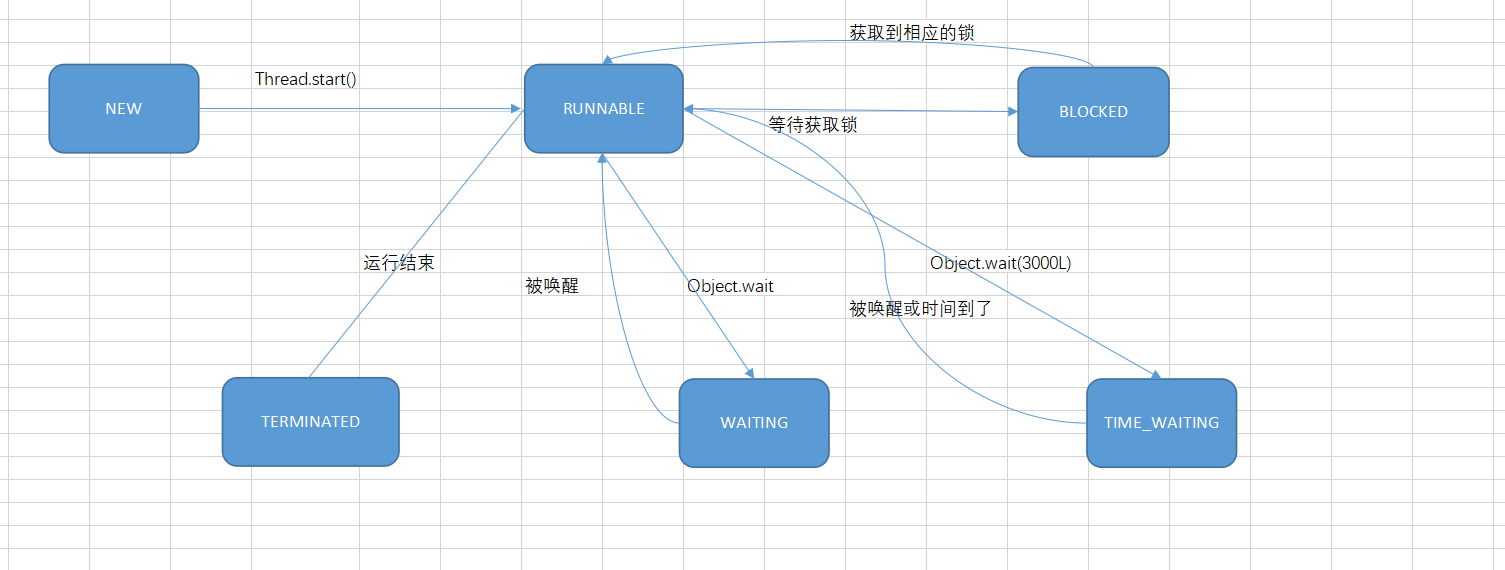1. 进程与线程的区别
-
进程:是系统进行分配和管理资源的基本单位
-
线程:进程的一个执行单元,是进程内调度的实体、是CPU调度和分派的基本单位,是比进程更小的独立运
行的基本单位。线程也被称为轻量级进程,线程是程序执行的最小单位。
-
一个程序至少一个进程,一个进程至少一个线程。
-
进程有自己的独立地址空间,每启动一个进程,系统就会为它分配地址空间,建立数据表来维护代码段、堆栈
段和数据段,这种操作非常昂贵。 而线程是共享进程中的数据的,使用相同的地址空间,因此CPU切换一个
线程的花费远比进程要小很多,同时创建一个线程的开销也比进程要小很多。 线程之间的通信更方便,同一
进程下的线程共享全局变量、静态变量等数据,而进程之间的通信需要以通信的方式进行。 如何处理好同步
与互斥是编写多线程程序的难点。 多进程程序更健壮,进程有独立的地址空间,一个进程崩溃后,在保护模
式下不会对其它进程产生影响, 而线程只是一个进程中的不同执行路径。线程有自己的堆栈和局部变量,但
线程之间没有单独的地址空间,所以可能一个线程出现问题,进而导致整个程序出现问题
2.线程的状态及其相互转换
初始(NEW):新创建了一个线程对象,但还没有调用start()方法。
运行(RUNNABLE):处于可运行状态的线程正在JVM中执行,但它可能正在等待来自操作系统的其他资源,例
如处理器。
阻塞(BLOCKED):线程阻塞于synchronized锁,等待获取synchronized锁的状态。
等待(WAITING):Object.wait()、join()、 LockSupport.park(),进入该状态的线程需要等待其他线程做出一些特
定动作(通知或中断)。
超时等待(TIME_WAITING):Object.wait(long)、Thread.join()、LockSupport.parkNanos()、
LockSupport.parkUntil,该状态不同于WAITING,它可以在指定的时间内自行返回。
终止(TERMINATED):表示该线程已经执行完毕。
2.1创建线程的方式(上)
继承Thread,并重写父类的run方法
实现Runable接口,并实现run方法
实际开发中,选第2种:java只允许单继承 增加程序的健壮性,代码可以共享,代码跟数据独立
2.2创建线程的方式(下)
使用匿名内部类
Lambda表达式
线程池
线程阻塞Demo:
public class ThreadStateDemo {
public static void main(String[] args) throws InterruptedException {
/**
* Block
*/
// Object obj = new Object();
// Thread thread = new Thread(()->{
//
// synchronized (obj){
//
// try {
// Thread.sleep(100000000L);
// } catch (InterruptedException e) {
// e.printStackTrace();
// }
// }
//
// });
//
// thread.start();
//
// Thread.sleep(2000L);
//
// Thread thread2 = new Thread(()->{
//
// synchronized (obj){
//
// }
//
// });
// thread2.start();
//
// }
/**
* waiting
*/
Object obj = new Object();
Thread thread = new Thread(() -> {
synchronized (obj) {
try {
obj.wait();
} catch (InterruptedException e) {
e.printStackTrace();
}
}
});
thread.start();
}
}
线程池开启单线程:
public class ThreadPool {
public static void main(String[] args) {
ExecutorService executorService = Executors.newSingleThreadExecutor();
executorService.execute(() -> {
System.out.println(Thread.currentThread().getName());
});
}
}
相应的图示如下:

3.线程的挂起跟恢复
什么是挂起线程? 线程的挂起操作实质上就是使线程进入“非可执行”状态下,在这个状态下CPU不会分给线程
时间片,进入这个状态可以用来暂停一个线程的运行。 在线程挂起后,可以通过重新唤醒线程来使之恢复运
行
3.1 为什么要挂起线程?
cpu分配的时间片非常短、同时也非常珍贵。避免资源的浪费。
如何挂起线程?
-
被废弃的方法 thread.suspend() 该方法不会释放线程所占用的资源。如果使用该方法将某个线程挂起,则可
能会使其他等待资源的线程死锁 thread.resume() 方法本身并无问题,但是不能独立于suspend()方法存在
-
可以使用的方法 wait() 暂停执行、放弃已经获得的锁、进入等待状态
-
notify() 随机唤醒一个在等待锁的线程
-
notifyAll() 唤醒所有在等待锁的线程,自行抢占cpu资源
被废弃的相关挂起Demo:
/**
* 挂起操作的Demo
*/
public class SuspendDemo implements Runnable{
@Override
public void run() {
System.out.println(Thread.currentThread().getName()+"进入Run()方法,准备调用SusPend");
Thread.currentThread().suspend(); //执行挂起
System.out.println(Thread.currentThread().getName()+"进入Run()方法,调用SusPend结束");
}
public static void main(String[] args) throws InterruptedException {
Thread thread = new Thread(new SuspendDemo());
thread.start();
Thread.sleep(3000L);
thread.resume(); //执行恢复
}
}
这里要注意的是挂起的操作是不安全的,被废弃也是因为因为他容易造成长时间阻塞:
这里阻塞的原因是因为他在挂起前就进行来了唤醒的操作,导致后来的线程一直挂起(未睡眠导致唤醒的代码提前于挂起执行了)
**
* suspend死锁演示
*/
public class DeadDemo implements Runnable{
private static final Object object =new Object();
@Override
public void run() {
//持有资源
synchronized (object){
System.out.println(Thread.currentThread().getName()+"占用资源");
Thread.currentThread().suspend();
}
System.out.println(Thread.currentThread().getName()+"释放资源");
}
public static void main(String[] args) throws InterruptedException {
Thread thread = new Thread(new DeadDemo(),"对比线程");
thread.start();
thread.sleep(1000L);
thread.resume();
Thread deadThread = new Thread(new DeadDemo(),"死锁线程");
deadThread.start();
// deadThread.sleep(3000L);
deadThread.resume();
}
}
使用推荐的wait和notify方法操作:
package xianchengxuexi.chapter02.hang;
import com.sun.jndi.toolkit.ctx.StringHeadTail;
/**
* 等待方法
*/
public class WaitDemo implements Runnable {
private static Object object = new Object();
private static Object waitObj = new Object();
@Override
public void run() {
//持有资源
//锁住的和wait()的需要时同一个对象
synchronized (waitObj){
System.out.println(Thread.currentThread().getName()+"占用资源");
try {
waitObj.wait();//这个会释放锁
} catch (InterruptedException e) {
e.printStackTrace();
}
}
System.out.println(Thread.currentThread().getName()+"释放资源");
}
public static void main(String[] args) throws InterruptedException {
Thread thread = new Thread(new WaitDemo(),"对比线程");
thread.start();
Thread thread2 = new Thread(new DeadDemo(),"对比线程2");
thread2.start();
thread.sleep(3000L);
synchronized (waitObj){
waitObj.notify();
}
}
}
3.2 什么时候适合使用挂起线程?
我等的船还不来(等待某些未就绪的资源),我等的人还不明白。直到notify方法被调用
3.3线程的中断操作
stop() 废弃方法,开发中不要使用。因为一调用,线程就立刻停止,此时有可能引发相应的线程安全性问题
/**
* 不安全的stop
*/
public class UnSafeWithStop extends Thread {
private int a =0;
private int b =0;
@Override
public void run() {
a++;
try {
sleep(2000L);
} catch (InterruptedException e) {
e.printStackTrace();
}
b++;
}
public void printf(){
System.out.println("a的值=======>"+a);
System.out.println("b的值=======>"+b);
}
public static void main(String[] args) throws InterruptedException {
UnSafeWithStop unSafeWithStop = new UnSafeWithStop();
unSafeWithStop.start();
Thread.sleep(1000L);
unSafeWithStop.stop();
unSafeWithStop.printf();
}
}
Thread.interrupt方法
/**
* 使用Interrupt终止线程
*/
public class InterruptDemo implements Runnable {
@Override
public void run() {
while (!Thread.currentThread().isInterrupted()){
System.out.println(Thread.currentThread().getName());
}
}
public static void main(String[] args) throws InterruptedException {
Thread thread = new Thread(new InterruptDemo());
thread.start();
thread.sleep(1000L);
thread.interrupt();
}
}
自行定义一个标志,用来判断是否继续执行
/**
* 自定义线程终止
*/
public class MyInterruptDemo implements Runnable{
private static volatile boolean FLAG = true;
@Override
public void run() {
while (FLAG){
System.out.println(Thread.currentThread().getName());
}
}
public static void main(String[] args) throws InterruptedException {
Thread thread = new Thread(new MyInterruptDemo());
thread.start();
Thread.sleep(1000L);
FLAG=false;
}
}
4.线程的优先级
线程的优先级告诉程序该线程的重要程度有多大。如果有大量线程都被堵塞,都在等候运行,程序会尽可能地先运行优先级的那个线程。
但是,这并不表示优先级较低的线程不会运行。若线程的优先级较低,只不过表示它被准许运行的机会小一些而已。
线程的优先级设置可以为1-10的任一数值,Thread类中定义了三个线程优先级,分别是:
MIN_PRIORITY(1)、NORM_PRIORITY(5)、MAX_PRIORITY(10),
一般情况下推荐使用这几个常量,不要自行设置数值。
/**
* 线程优先级Demo
*/
public class ProrityDemo {
public static void main(String[] args) {
Thread thread = new Thread(() -> {
while (true){
System.out.println(Thread.currentThread().getName());
}
},"线程1");
Thread thread2 = new Thread(() -> {
while (true){
System.out.println(Thread.currentThread().getName());
} },"线程2");
thread.setPriority(Thread.MIN_PRIORITY);
thread2.setPriority(Thread.MAX_PRIORITY);
thread.start();
thread2.start();
}
}
不同平台,对线程的优先级的支持不同。 编程的时候,不要过度依赖线程优先级,如果你的程序运行是否正
确取决于你设置的优先级是否按所设置的优先级运行,那这样的程序不正确
任务:
快速处理:设置高的优先级 慢慢处理:设置低的优先级
5.守护线程
线程分类
用户线程、守护线程 守护线程:任何一个守护线程都是整个程序中所有用户线程的守护者,只要有活着的用
户线程,守护线程就活着。当JVM实例中最后一个非守护线程结束时,也随JVM一起退出
守护线程的用处:jvm垃圾清理线程
建议: 尽量少使用守护线程,因其不可控不要在守护线程里去进行读写操作、执行计算逻辑
/**
* 守护线程Demo
*/
public class DaemonThreadDemo implements Runnable{
@Override
public void run() {
while (true) {
System.out.println(Thread.currentThread().getName());
try {
Thread.sleep(1000L);
} catch (InterruptedException e) {
e.printStackTrace();
}
}
}
public static void main(String[] args) throws InterruptedException {
Thread thread = new Thread(new DaemonThreadDemo());
thread.start();
thread.setDaemon(true);
Thread.sleep(2000L);
}
}